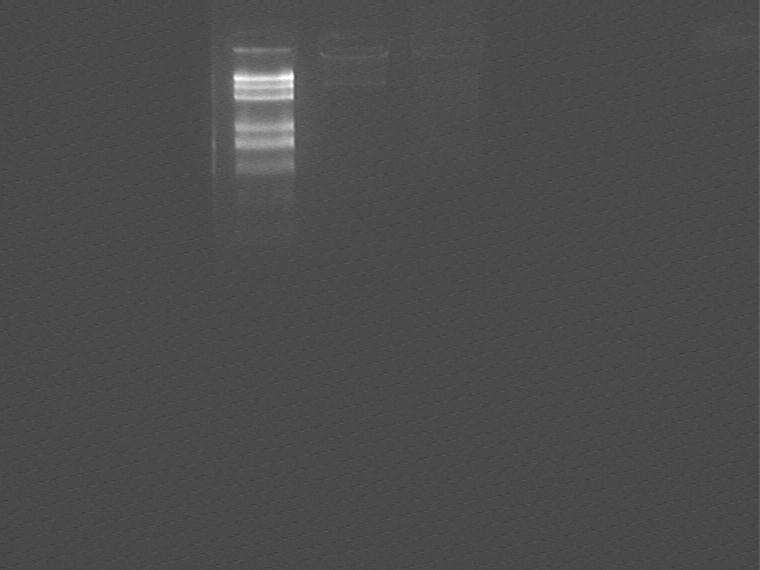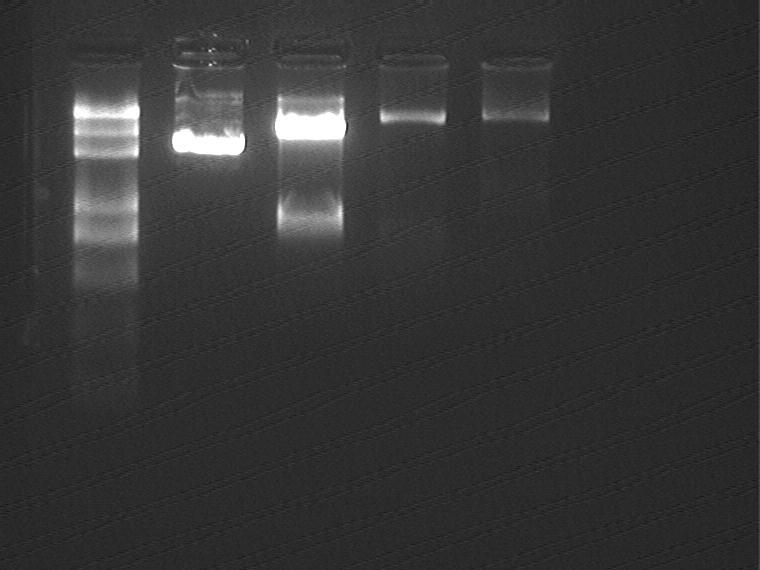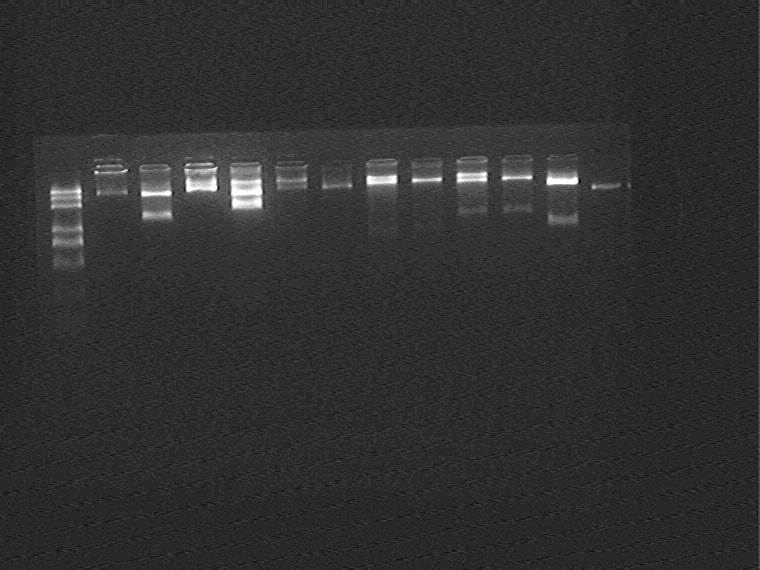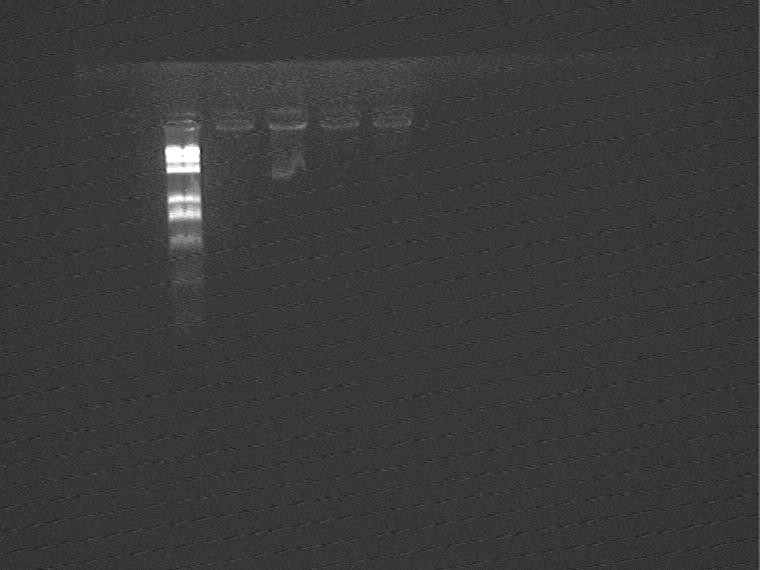Notebook > Bistable
2009.7.30
9:00
Electrophoresis to test the products of the digestion.
The order of the samples: marker, plasmids control, digestion products.
Results:

It is difficult to tell the digestion fragments, maybe because of the poor concentration of the plasmids.
20:00
Digest the PYFP plasmids into vectors.
Digest to standardize:
| Total | 20μL
|
| Plasmids | 7μL
|
| Spe1 | 1μL
|
| Pst1 | 1μL
|
| Buffer | 2μL
|
| ddH2O | 9μL
|
Digest to connect with high-copy bi-stable fragments.
| Total | 20μL
|
| Plasmids | 10μL
|
| EcoR1 | 1μL
|
| Kpn1 | 1μL
|
| Buffer | 2μL
|
| ddH2O | 6μL
|
Digest the standardizing PCR fragments into inserts:
| Total | 20μL
|
| Plasmids | 17μL
|
| Xba1 | 1μL
|
| Buffer | 2μL
|
Digest T7P + 1-12M to get the high-copy backbone.
| Total | 20μL
|
| Plasmids | 4μL
|
| Xba1 | 1μL
|
| Spe1 | 1μL
|
| Buffer | 2μL
|
| ddH2O | 12μL
|
2009.7.31
10:30
Electrophoresis the digestion products.
The order of the samples: marker, digestion products for backbone, single digestion products of the standardized fragments, double digestion products of PYFP cut by Kpn1 and EcoR1, double digestion products of PYFP cut by Spe1 and Pst1.
Results:

Recycle the fragments.
12:00
Digest the single digestion products of PYFP by another enzyme.
| Total | 30μL
|
| Fragments | 25.5μL
|
| Apal1 | 1.5μL
|
| Buffer | 3μL
|
12:40
Start to digest.
14:00
Miniprep.
| Number of the plasmids | Concentration(ng/μL)
|
| PKD46 | 53.68
|
| High-copy bi-stable | 102.61
|
| PKD3 | 139.91
|
| Psp20 | 72.955
|
| PYFP | 100.805
|
16:00
Digest high-copy bi-stable plasmids.
| Total | 20μL
|
| Plasmids | 15μL
|
| Xba1 | 1μL
|
| Nhe1 | 1μL
|
| Spe1 | 1μL
|
| Buffer | 2μL
|
16:30
Start to digest.
16:30
Start to recycle the fragments digested by ApaL1
17:30
Link the standard fragments with PYFP vectors, also high-copy bi-stable fragments with PYFP vectors.
| Total | 10μL
|
| Vectors | 2μL
|
| Inserts | 6μL
|
| T4 ligase | 1μL
|
| Buffer | 1μL
|
22:00
Electrophoresis to test the digestion products.
The order of the samples: marker, high-copy control plasmids, digestion products.
Results:
Digestion is successful. Recycle the fragments of about 3kb.
22:30
Transform the ligation products into DH5a.
2009.8.1
00:30
Start to incubate.
13:30
There is no colony on the plates.
21:00
Digest the high-copy bi-stable plasmids and low-copy bi-table plasmids.
High-copy bi-stable plasmids:
| Total | 20μL
|
| Plasmids | 2μL
|
| EcoR1 | 1μL
|
| Spe1 | 1μL
|
| Buffer | 2μL
|
| ddH2O | 13μL
|
Low-copy bi-stable plasmids:
| Total | 20μL
|
| Plasmids | 7μL
|
| EcoR1 | 1μL
|
| Nhe1 | 1μL
|
| Spe1 | 1μL
|
| Buffer | 2μL
|
| ddH2O | 8μL
|
PYFP:
| Total | 20μL
|
| Plasmids | 10μL
|
| EcoR1 | 1μL
|
| Kpn1 | 1μL
|
| Buffer | 2μL
|
| ddH2O | 6μL
|
| Total | 20μL
|
| Plasmids | 10μL
|
| Pst1 | 1μL
|
| Spe1 | 1μL
|
| Buffer | 2μL
|
| ddH2O | 6μL
|
Digest T7P + 1-12M for backbone:
| Total | 20μL
|
| Plasmids | 4μL
|
| EcoR1 | 1μL
|
| Spe1 | 1μL
|
| Buffer | 2μL
|
| ddH2O | 12μL
|
22:00
Start to digest.
2009.8.2
1:00
Electrophoresis to test the digestion products.
The order of the samples: marker, high-copy plasmids, high-copy digestion products, low-copy plasmids, low-copy digestion products, PYFP plasmids, PYFP digestion products by EK, PYFP digestion products by SP, T7P+1-12M plasmids, T7P+1-12M digestion products.
Results:

Electrophoresis the fragments used in the ligation the day before.
Results:

The concentrations of the fragments are too low, so that cause the ligation to fail.
2:00
Recycle the fragments.
4:00
Connect the bi-stable fragments, standard fragments with PYFP vectors.
Connect the high-copy bi-stable fragments and low-copy bi-stable fragments with the high-copy backbone.
| Total | 10μL
|
| Vectors | 2μL
|
| Inserts | 6μL
|
| T4 ligase | 1μL
|
| Buffer | 1μL
|
13:00
Transform those ligation products into DH5a.
2009.8.3
8:30
There are many colonies on all the plates.
9:30
Start to shake the colonies in the incubator.
11:30
PCR to test the colonies at the same time.
| Total | 20μL
|
| Template | Colonies
|
| For | 1μL
|
| Rev | 1μL
|
| Mix | 10μL
|
| ddH2O | 8μL
|
17:00
Electrophoresis to test the PCR products.
The order of the samples: standardized PYFP, marker, PYFP with bi-stable parts, high-copy bi-stable parts, marker, low-copy bi-stable parts.
23:00
Miniprep.
| Number of the plasmids | Concentration(ng/μL)
|
| PYFP with bi-stable parts 1 | 123.9
|
| PYFP with bi-stable parts 2 | 92.54
|
| PYFP with bi-stable parts 3 | 109.42
|
| PYFP with bi-stable parts 5 | 44.68
|
| Low-copy bi-stable parts 3 | 81.195
|
| Low-copy bi-stable parts 4 | 321.055
|
| High-copy bi-stable parts 3 | 160.98
|
| High-copy bi-stable parts 4 | 100.805
|
| PYFP with standardized fragments 5 | 55.82
|
2009.8.4
2:30
Digest and PCR those plasmids to test if they are correct.
PYFP with bi-stable parts:
| Total | 20μL
|
| Plasmids | 3μL
|
| EcoR1 | 1μL
|
| Kpn1 | 1μL
|
| Buffer | 2μL
|
| ddH2O | 13μL
|
High-copy and low-copy bi-stable parts with high-copy backbone:
| Total | 20μL
|
| Plasmids | 3μL
|
| EcoR1 | 1μL
|
| Pst1 | 1μL
|
| Buffer | 2μL
|
| ddH2O | 13μL
|
PYFP vectors with standardized fragments:
| Total | 20μL
|
| Plasmids | 6μL
|
| Pst1 | 1μL
|
| Spe1 | 1μL
|
| Buffer | 2μL
|
| ddH2O | 1μL
|
This is to test if the restriction enzyme sites are successfully been erased.
PCR to test standardization:
| Total | 20μL
|
| Template | 1μL
|
| For | 1μL
|
| Rev | 1μL
|
| Mix | 10μL
|
| ddH2O | 7μL
|
10:30
Electrophoresis to test if the PCR and digestion products are correct.
The order of the samples:
Marker, PYFP with bi-stable parts plasmids control, PYFP with bi-stable digestion products 1,2,3,5, PCR products of standardization, the digestion products of standardization.
Marker, low-copy bi-stable parts, high-copy bi-stable parts.
Results:

The PFYP with the bi-stable parts are correct.
16:00
Make up SOB.
100ML
2009.8.5
10:00
Prepare competent cells for electrical transformation.
20:00
Digest the PYFP with bi-stable parts to get the inserts.
| Total | 50μL
|
| Plasmids | 10μL
|
| Sap1 | 1.5μL
|
| Sph1 | 1.5μL
|
| Buffer | 5μL
|
| ddH2O | 32μL
|
2009.8.6
12:30
Recycle the digestion products.
13:30
Prepare SOC.
20:00
Electroporation:
Parameters: 50μLwith 400ng DNA fragments.
2.5kV, 25mF, 200ohms.
Incubate in SOC for 2h.
2009.8.7
There is one colony on the plate, but it is the result of reconnection of the plasmids.
^Top
|